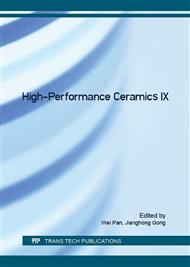[1]
W. Heywang, H. Thomann. Electronic Ceramics [M], London and New York, (1991).
Google Scholar
[2]
G. Arlt, D. Hennings, G. de, Dielectric properties of fine-grained barium titanate ceramics, J. Appl. Phys. 58 (1985) 1619-1625.
DOI: 10.1063/1.336051
Google Scholar
[3]
D. Hennings, Barium titanate based ceramic materials for dielectric use, Int. J. High Tech. Ceram. 3 (1987) 91-111.
Google Scholar
[4]
M. Kahn, Preparation of Small-Grained and Large-Grained Ceramics from Nd-Doped BaTiO3, J. Am. Ceram. Soc. 54 (1971) 452-454.
DOI: 10.1111/j.1151-2916.1971.tb12383.x
Google Scholar
[5]
M. N. Rahaman, R. Manalert, Grain boundary mobility of BaTiO3 dopedwith aliovalent cations, J. Eur. Ceram. Soc. 18 (1998) 1063-1071.
DOI: 10.1016/s0955-2219(97)00215-x
Google Scholar
[6]
S. K. Chiang, W. E. Lee, D. W. Readey, Core-Shell Structure in Doped BaTiO3, Am. Ceram. Bull. 66 (1987) 1230.
Google Scholar
[7]
X. X. Wang, H. L. W. Chan, Positive temperature coefficient of resistivity effect in niobium-doped barium titanate ceramics obtained at low sintering temperature, J. Eur. Ceram. Soc. 24 (2004) 1227.
DOI: 10.1016/s0955-2219(03)00379-0
Google Scholar
[8]
H. Takeda, Y. Hoshi, T. Kinoshita, et al., CFabrication of lead-free and high Tc BaTiO3-based thermistor ceramics using deoxidizing effect of oxygen-containing α-zirconium, Ceram. Int. 34 (2008) 2073-(2077).
DOI: 10.1016/j.ceramint.2007.08.009
Google Scholar
[9]
Y. Pu, J. Wei, Y. Mao, J. Wang, Positive temperature coefficient of resistivity behavior of Niobium- doped (1−x)BaTiO3–xBi0. 5Li0. 5TiO3 ceramics, J. Alloy. Compd. 498 (2010) 5-7.
DOI: 10.1016/j.jallcom.2010.03.149
Google Scholar
[10]
S. L. Jiang, Q. Jiang, H. B. Zhang, S. P. Gong, Study on BaTiO3 semiconducting ceramic materials with lower resistivity, J. Electroceramics. 21 (2008) 694-697.
DOI: 10.1007/s10832-007-9266-4
Google Scholar
[11]
S. W. Ding, G. Jia, J. Wang, Z. Y. He, Electrical properties of Y-and Mn-doped BaTiO3-based PTC ceramics, Ceram. Int. 34 (2008) 2007-(2010).
DOI: 10.1016/j.ceramint.2007.07.023
Google Scholar
[12]
I. H. Kim, H. W. Lee, Y. M. Kim, H. J. Kim, S. C. Ur, PTCR properties of Sb2O3-doped (Ba, Sr)TiO3, Mater. Let. 60 (2006) 3027-3030.
DOI: 10.1016/j.matlet.2006.02.037
Google Scholar
[13]
W. R. Huo, Y. F. Qu, Effects of Bi1/2Na1/2TiO3 on the Curie temperature and the PTC effects of BaTiO3-based positive temperature coefficient ceramics, Sens. Actuators A. 128 (2006) 265-269.
DOI: 10.1016/j.sna.2006.01.022
Google Scholar
[14]
Y. Pu, H. Wu, J. Wei, B. Wang, Influence of doping Nb5+ and Mn2+ on the PTCR effects of Ba0. 92Ca0. 05(Bi0. 5Na0. 5)0. 03TiO3 ceramics, J. Mater. Sci.: Mater. Electron. 22 (2011) 1479-1482.
DOI: 10.1007/s10854-011-0333-x
Google Scholar
[15]
E. D. Macklen, Thermistors, Electrochemical Publications. (1979)188-217.
Google Scholar
[16]
E. Brzozowski, M. S. Castro, Influence of Nb5+ and Sb3+ dopants on the defect profile, PTCR effect and GBBL characteristics of BaTiO3 ceramics, J. Eur. Ceram. Soc. 24 (2004) 2499-2507.
DOI: 10.1016/j.jeurceramsoc.2003.07.015
Google Scholar
[17]
O. Saburi, Properties of semiconductive barium titanates, J. Phys. Soc. Jpn. 14 (1959) 1159-1174.
DOI: 10.1143/jpsj.14.1159
Google Scholar
[18]
H. T. Langhammer, D. Makovec, Y. Pu, H. Abicht, M. Drofenik, Grain boundary reoxidation of donor-doped barium titanate ceramics, J. Eur. Ceram. Soc. 26 (2006) 2899-2907.
DOI: 10.1016/j.jeurceramsoc.2006.02.006
Google Scholar
[19]
D. Makovec, Z. Samardžija, D. Kolar, Solid solubility of cerium in BaTiO3,J. Solid State Chem. 123 (1996) 30-38.
DOI: 10.1006/jssc.1996.0148
Google Scholar
[20]
D. F. K. Hennings, B. Schreinemacher, H. Schreinemacher, High-permittivity dielectric ceramics with high endurance,J. Eur. Ceram. Soc. 13 (1994) 81-88.
DOI: 10.1016/0955-2219(94)90062-0
Google Scholar
[21]
Y. Y. Lu, T. Y, Electrical characteristics of (Pb, Sr)TiO3 positive temperature coefficient ceramics, Mater. Chem. Phys. 53 (1998)132-137.
DOI: 10.1016/s0254-0584(97)02073-7
Google Scholar
[22]
C. Rath, P. Mohanty, A. C. Pandey, N. C. Mishra, Oxygen vacancy induced structural phase transformation in TiO2 nanoparticles, J. Phys. D: Appl. Phys. 42 (2009) 205101.
DOI: 10.1088/0022-3727/42/20/205101
Google Scholar


